How to write high-quality PHP code

Written for those newborn calves who are not afraid of tigers, you can read it at will. This chapter is based on PHP Laravel
Preface
People often ask
- How to design a directory better?
- How to distribute the code well?
- How to write a maintainable project?
I also write about "bad" projects. The following is based on the summary of articles and personal development experience of major Internet experts.
Controller
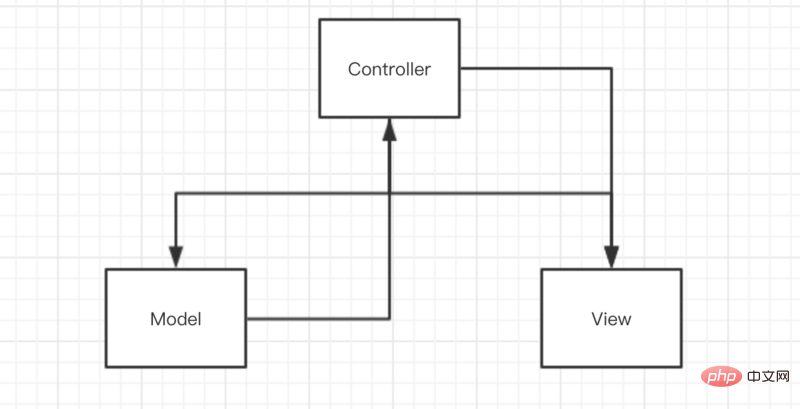
Controller, as the name suggests, is a controller. When you get started with PHP, you know that Controller represents the C layer in MVC. The concept of MVC itself is code separation, which teaches you how to separate businesses. However, as the business continues to develop, the complexity of the code also increases, and the links between functions are intricate. In the end, your MVC becomes As shown in the figure below, relying solely on the MVC design idea can no longer support the growing business.
Now we redefine the tasks and capabilities of the Controller. The controller only controls Http Reqeust requests, which complies with the SOLID single function principle.
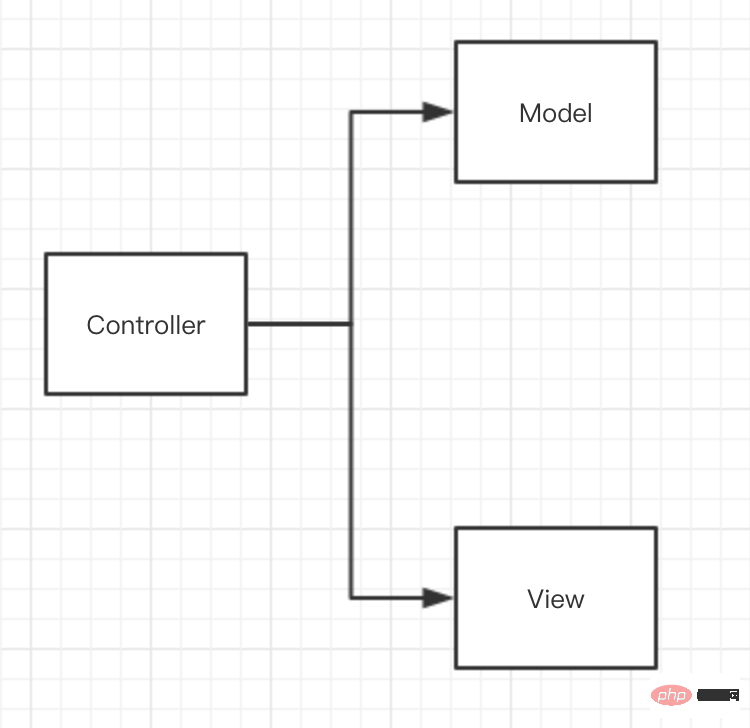
Writing business code directly in the Controller will make the code extremely bloated and difficult to maintain and expand
<?php namespace App\Http\Controller;
class UserController extends Controller{
public function register(Request $request){ $user = new User(); $user->username = $request->input('username'); $user->password = $request->input('password'); $result = $user->save(); return $result;
}
}复制代码At this time, we should think about how to separate the business code, and we introduce the concept of Service
Service
Service itself is translated as service
- Inject external methods and public methods into Service
- Inject Service into the controller
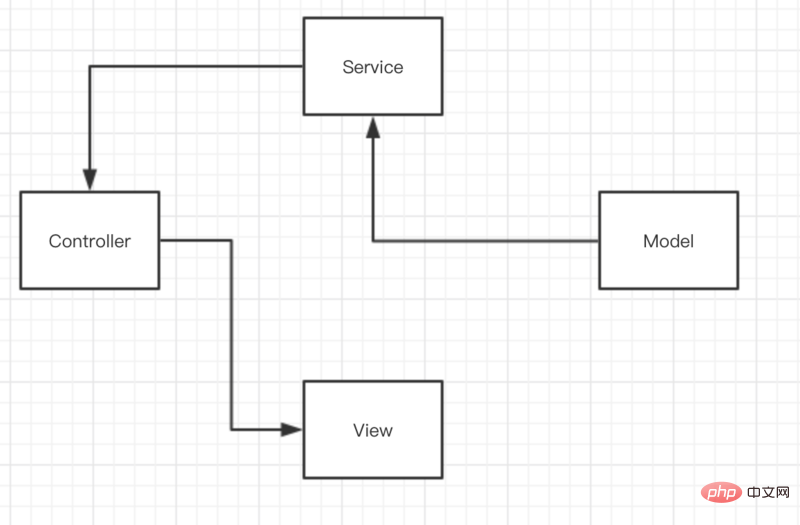
Like the picture above
UserController
<?php namespace App\Http\Controller;
class UserController extends Controller{
public $request;
protected $userService;
public function __construct(Request $request, UserService $userService)
{ $this->request = $request;
$this->userService = $userService;
}
public function register()
{
//... validation return $this->userService->register ($this->request->all());
}
}复制代码UserService
<?php namespace App\Service;
class UserService{
public function register($data)
{ $username = $data['username']; $password = $data['password'];
$password = encrypt ($password);
$user = new User(); $user->username = $username; $user->password = $password; $result = $user->save(); return $result;
}
}复制代码Until now , we at least completely separate the business from the requests. But it is still unsatisfactory. If all business and CURD are written in Service, it will just transfer the bloat of Controller to Service, and then Service will have no meaning in existence. Therefore, we need to continue to divide the Service and separate the R operations of the database, because the operations of CUD are basically the same, while the R operations become more colorful according to the complexity of the business. So standalone R operation. At this time we refer to the concept of Repository.
Repository
We use Repository auxiliary Model to encapsulate relevant query logic into different repositories to facilitate the maintenance of logic code
- Conforms to the single principle of SOLID
- SOLID-compliant dependency inversion
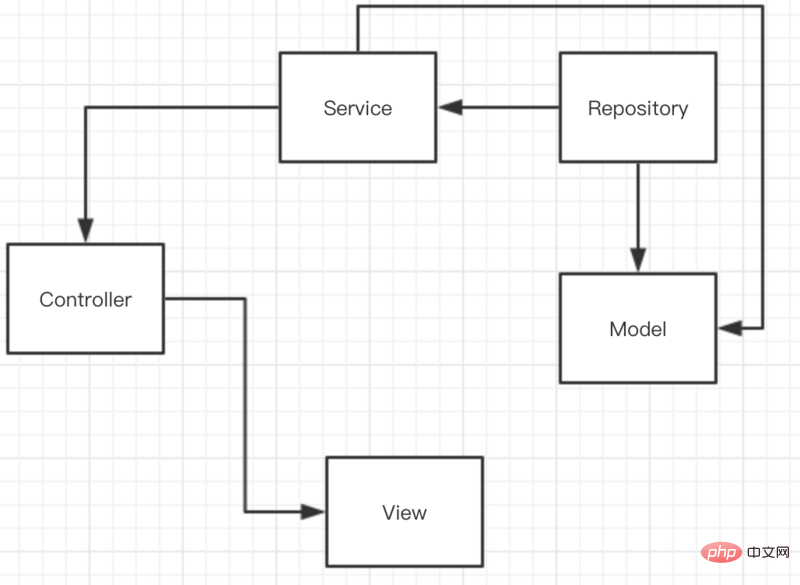
<?php namespace App\Http\Controller;
class UserController extends Controller{
public $request;
protected $userService;
public function __construct(Request $request, UserService $userService)
{ $this->request = $request;
$this->userService = $userService;
}
public function getUserInfo()
{
//... validation return $this->userService->getUserInfo ($this->request->all());
}
}复制代码Copy after login
UserService<?php namespace App\Http\Controller;
class UserController extends Controller{
public $request;
protected $userService;
public function __construct(Request $request, UserService $userService)
{ $this->request = $request;
$this->userService = $userService;
}
public function getUserInfo()
{
//... validation return $this->userService->getUserInfo ($this->request->all());
}
}复制代码<?php namespace App\Service;
class UserService{
public $userRepository;
public function __construct(UserRepository $userRepository){ $this->userRepository = $userRepository;
}
public function getUserInfo()
{ return $this->userRepository->getUserInfo($data);
}
}复制代码Copy after login
UserRepository<?php namespace App\Service;
class UserService{
public $userRepository;
public function __construct(UserRepository $userRepository){ $this->userRepository = $userRepository;
}
public function getUserInfo()
{ return $this->userRepository->getUserInfo($data);
}
}复制代码<?php namespace App\Repository;
class UserRepository{
public function getUserInfo($data)
{ $userId = $data['user_id']; $result = User::where('id',$userId)->first();
return $result;
}
}复制代码Copy after loginCopy after login
After solving the problem of R, someone asked, can it be put together because CUD is relatively unified and simple? The answer is NO, we quote a new noun Action. Action
<?php namespace App\Repository;
class UserRepository{
public function getUserInfo($data)
{ $userId = $data['user_id']; $result = User::where('id',$userId)->first();
return $result;
}
}复制代码This is what I learned after reading @Charlie_Jade’s articleIndependent of each operation file, such as CreateUser, DeleteUser, UpdateUser
- Conform to the single principle of SOLID

<?php namespace App\Http\Controller;
class UserController extends Controller{
public $request;
protected $userService;
public function __construct(Request $request, UserService $userService)
{ $this->request = $request;
$this->userService = $userService;
}
public function register(){
//... validation return $this->userService->register($this->request->all());
}
public function getUserInfo()
{ return $this->userService->getUserInfo ($this->request->all());
}
}复制代码UserService
<?php namespace App\Service;
class UserService{
public function getUserInfo(UserRepository $userRepository)
{ return $this->userRepository->getUserInfo($data);
}
public function register(){ $result = (new CreateUser())->execute($this->request->all());
return $result;
}
}复制代码UserRepository
<?php namespace App\Repository;
class UserRepository{
public function getUserInfo($data)
{ $userId = $data['user_id']; $result = User::where('id',$userId)->first();
return $result;
}
}复制代码CreateUser
<?php namespace App\Action;
use App\Model\Member;
class CreateUser extends CreateUserWallet
{
public function execute(array $data)
{ $models = new Member(); $models->tel = $data['tel']; $models->password = $data['password']; $result = $models->save ();
return $result;
}
}复制代码The above code logic is shown in the figure below
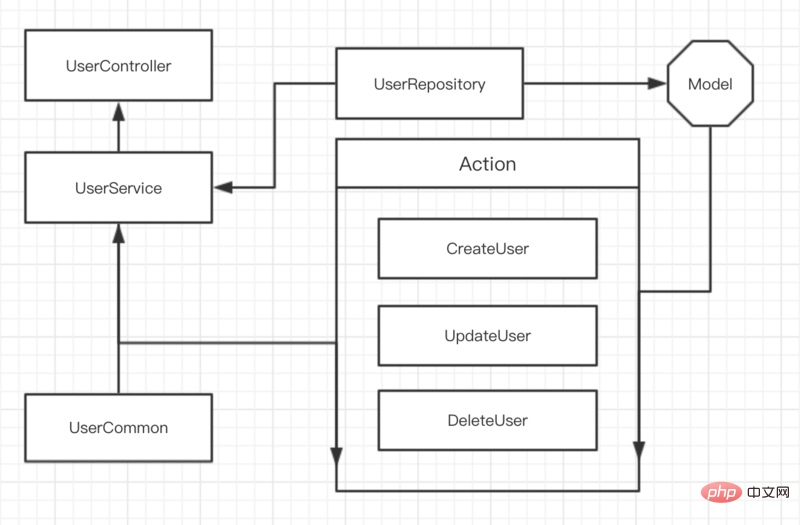
Common
is translated as public, commonly used. In some development, you may need some public methods (non-public classes, such as email sending, etc., it is not appropriate to use them), such as query User balance, query whether the user is registered or online, generate order number, etc. Using Common is even simpler. It is more like a public function library
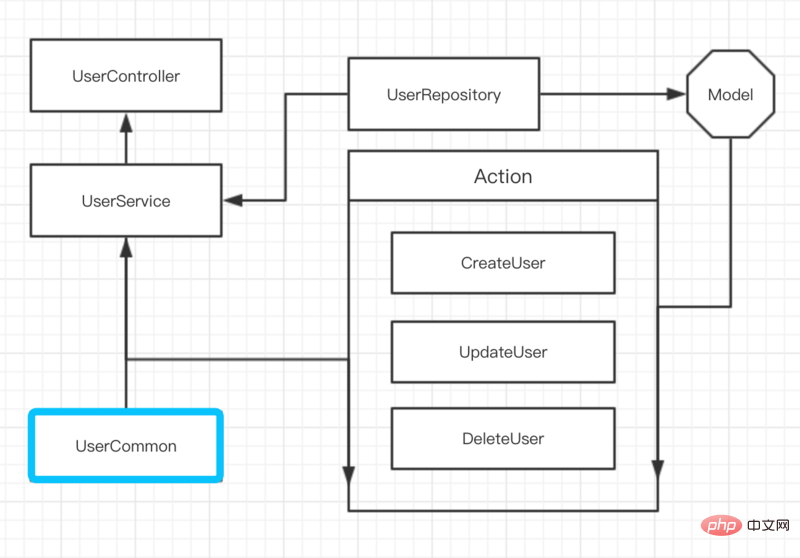
Event
You can choose to use it when you don’t care about the execution results, but the Listen of Event Queues are also provided.
Exception
Don’t use Return to return all your error messages. In many cases, your return may not be your return
Thank you
Thank you all After reading this article, if you have any new ideas, please feel free to discuss them in the comment area.
Recommended tutorial: "php tutorial"
The above is the detailed content of How to write high-quality PHP code. For more information, please follow other related articles on the PHP Chinese website!

Hot AI Tools

Undresser.AI Undress
AI-powered app for creating realistic nude photos

AI Clothes Remover
Online AI tool for removing clothes from photos.

Undress AI Tool
Undress images for free

Clothoff.io
AI clothes remover

Video Face Swap
Swap faces in any video effortlessly with our completely free AI face swap tool!

Hot Article

Hot Tools

Notepad++7.3.1
Easy-to-use and free code editor

SublimeText3 Chinese version
Chinese version, very easy to use

Zend Studio 13.0.1
Powerful PHP integrated development environment

Dreamweaver CS6
Visual web development tools

SublimeText3 Mac version
God-level code editing software (SublimeText3)

Hot Topics
 1664
1664
 14
14
 1421
1421
 52
52
 1315
1315
 25
25
 1266
1266
 29
29
 1239
1239
 24
24
 Laravel Introduction Example
Apr 18, 2025 pm 12:45 PM
Laravel Introduction Example
Apr 18, 2025 pm 12:45 PM
Laravel is a PHP framework for easy building of web applications. It provides a range of powerful features including: Installation: Install the Laravel CLI globally with Composer and create applications in the project directory. Routing: Define the relationship between the URL and the handler in routes/web.php. View: Create a view in resources/views to render the application's interface. Database Integration: Provides out-of-the-box integration with databases such as MySQL and uses migration to create and modify tables. Model and Controller: The model represents the database entity and the controller processes HTTP requests.
 The Continued Use of PHP: Reasons for Its Endurance
Apr 19, 2025 am 12:23 AM
The Continued Use of PHP: Reasons for Its Endurance
Apr 19, 2025 am 12:23 AM
What’s still popular is the ease of use, flexibility and a strong ecosystem. 1) Ease of use and simple syntax make it the first choice for beginners. 2) Closely integrated with web development, excellent interaction with HTTP requests and database. 3) The huge ecosystem provides a wealth of tools and libraries. 4) Active community and open source nature adapts them to new needs and technology trends.
 Laravel user login function
Apr 18, 2025 pm 12:48 PM
Laravel user login function
Apr 18, 2025 pm 12:48 PM
Laravel provides a comprehensive Auth framework for implementing user login functions, including: Defining user models (Eloquent model), creating login forms (Blade template engine), writing login controllers (inheriting Auth\LoginController), verifying login requests (Auth::attempt) Redirecting after login is successful (redirect) considering security factors: hash passwords, anti-CSRF protection, rate limiting and security headers. In addition, the Auth framework also provides functions such as resetting passwords, registering and verifying emails. For details, please refer to the Laravel documentation: https://laravel.com/doc
 How to learn Laravel How to learn Laravel for free
Apr 18, 2025 pm 12:51 PM
How to learn Laravel How to learn Laravel for free
Apr 18, 2025 pm 12:51 PM
Want to learn the Laravel framework, but suffer from no resources or economic pressure? This article provides you with free learning of Laravel, teaching you how to use resources such as online platforms, documents and community forums to lay a solid foundation for your PHP development journey from getting started to master.
 Laravel framework installation method
Apr 18, 2025 pm 12:54 PM
Laravel framework installation method
Apr 18, 2025 pm 12:54 PM
Article summary: This article provides detailed step-by-step instructions to guide readers on how to easily install the Laravel framework. Laravel is a powerful PHP framework that speeds up the development process of web applications. This tutorial covers the installation process from system requirements to configuring databases and setting up routing. By following these steps, readers can quickly and efficiently lay a solid foundation for their Laravel project.
 What versions of laravel are there? How to choose the version of laravel for beginners
Apr 18, 2025 pm 01:03 PM
What versions of laravel are there? How to choose the version of laravel for beginners
Apr 18, 2025 pm 01:03 PM
In the Laravel framework version selection guide for beginners, this article dives into the version differences of Laravel, designed to assist beginners in making informed choices among many versions. We will focus on the key features of each release, compare their pros and cons, and provide useful advice to help beginners choose the most suitable version of Laravel based on their skill level and project requirements. For beginners, choosing a suitable version of Laravel is crucial because it can significantly impact their learning curve and overall development experience.
 How to view the version number of laravel? How to view the version number of laravel
Apr 18, 2025 pm 01:00 PM
How to view the version number of laravel? How to view the version number of laravel
Apr 18, 2025 pm 01:00 PM
The Laravel framework has built-in methods to easily view its version number to meet the different needs of developers. This article will explore these methods, including using the Composer command line tool, accessing .env files, or obtaining version information through PHP code. These methods are essential for maintaining and managing versioning of Laravel applications.
 The difference between laravel and thinkphp
Apr 18, 2025 pm 01:09 PM
The difference between laravel and thinkphp
Apr 18, 2025 pm 01:09 PM
Laravel and ThinkPHP are both popular PHP frameworks and have their own advantages and disadvantages in development. This article will compare the two in depth, highlighting their architecture, features, and performance differences to help developers make informed choices based on their specific project needs.




